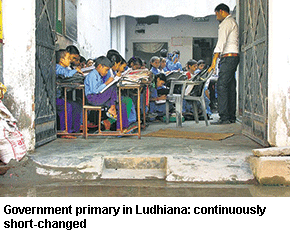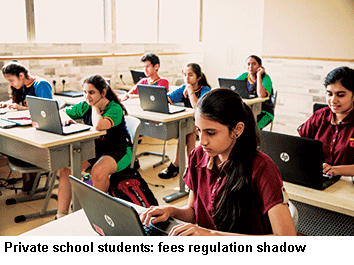Against the grim backdrop of falling learning outcomes in the country’s school and higher education systems, some of India’s most respected school principals, leaders and vice chancellors suggest ways and means to manage the existential crisis that confronts Indian education - Summiya Yasmeen
 Indian education — especially public education — is experiencing an existential crisis. News from across the entire spectrum of education — pre-primary, primary, secondary, higher secondary, collegiate and university — is dismal and portends great anguish and uncertainty for 21st century India which grudgingly hosts the world’s largest child and youth population (670 million) below age 24.
Indian education — especially public education — is experiencing an existential crisis. News from across the entire spectrum of education — pre-primary, primary, secondary, higher secondary, collegiate and university — is dismal and portends great anguish and uncertainty for 21st century India which grudgingly hosts the world’s largest child and youth population (670 million) below age 24.
Sustained under-investment in public education by post-independence India’s political class, indifference of business and industry and apathy of the country’s self-serving academics and the intelligentsia, has rendered the overwhelming majority of the nation’s youngest citizens vulnerable to great hardship and suffering in the rapidly emerging globalised economy in which capability to intelligently compete for customers and market share is likely to unsparingly separate winners and losers. Unless India’s moribund education system is urgently reformed root and branch, there’s real danger that our children and youth will become hewers of wood and carriers of water, i.e, coolies, of the fast crystallising 21st century economy.
The weight of evidence of systemic rot within Indian education is mountainous. Year after year, the Annual Status of Education Report published by the globally respected Mumbai/Delhi-based NGO Pratham Education Foundation, which field-tests the real learning outcomes of primary school children in rural India through a massive volunteer workforce, has been reporting that over 50 percent children in class V cannot read class II textbooks. Nor can they do simple sums.
Last year, in a refreshing departure from past practice of testing primary school children, Pratham volunteers field tested 30,532 adolescents in the age group 14-18 from 25,726 households in rural India. The recently released ASER 2017 assesses whether adolescents who have completed elementary education (class I-VIII) are learning for further study, pursuing vocational education or working. In addition, they tested them for utilisation of literacy and numeracy skills, their familiarity with digital and financial instruments, exposure to media, and whether they had career goals.
Dismally, ASER 2017 indicates that the learning deficits of elementary school are carried forward as teens transform into young adults. It highlights that a quarter of young citizens in this age group still cannot read basic texts in their vernacular languages and more than half struggle with simple — three digits by one — division sums. Unsurprisingly, the report reveals that 14 percent of adolescents are not enrolled in any learning programme, a mere 5.3 percent are enrolled in VET (vocational education and training) programmes, 31 percent are working — most of them in the farm sector — and the remainder have migrated to the cities to do low-end jobs there. Although 73 percent of the 30,532 sampled students were familiar with mobile phones, only 28 percent had used the Internet in the previous week, 26 percent had used computers in the previous week, 59 percent have never used a computer and 64 percent have never used the Internet. It’s a colossal waste of high-potential human resources.
Inevitably, learning outcomes in secondary education are not better. In 2010, a batch of students from mid-priced private and government schools in Himachal Pradesh and Tamil Nadu were selected to write PISA (Programme for International Student Assessment), a test organised at three year intervals by the developed OECD countries to assess the relative language and maths capabilities of 15-year-olds. The Indian cohort of selected students was ranked #173 of 174 countries that wrote PISA eight years ago. Since then, the Union government has withdrawn from participating in PISA.
In the circumstances, it’s hardly surprising that none of India’s 39,071 undergrad colleges or 799 universities — some of them established over 150 years ago — feature in the Top 100 WUR (World University Rankings) league tables published annually by the highly-respected London-based university rating and ranking institutions Quacquarelli Symonds and Times Higher Education. India’s highest ranked university by QS is IIT-Bombay (estb.1958) at #179 and the Indian Institute of Science, Bangalore (estb. 1909) by THE at #152. The unkindest cut is that our hostile neighbour China, which had no higher education system to speak of in 1949 when the communist People’s Republic was declared in Beijing, has six in the Top 100 of the QS league table and seven in the THE Top 200.
Yet evidently not content with having almost destroyed post-independence India’s public education system by way of continuous under-investment (see p.84), teacher recruitment and transfer, textbooks printing and publishing and numerous other rackets, the neta-babu establishment has turned its baleful eye on the country’s 320,000 private (financially independent) K-12 schools which, despite their small number host almost 40 percent of the country’s school-going children and — particularly the Top 1,000 — are islands of primary-secondary education excellence in a sea of mediocrity.
 In 2009, at the beginning of its second term in office, the Congress-led UPA II government at the Centre enacted the Right of Children to Free & Compulsory Education (RTE) Act, 2009 under which it became obligatory for the State to provide free-of-charge primary and upper primary education to all children in the 6-14 age group. However, under s.12 (1) (c) of the Act, private independent schools are obliged to reserve 25 percent capacity in class I every year for children from poor households in their neighbourhood and provide them free- of- charge education until they complete class VIII.
In 2009, at the beginning of its second term in office, the Congress-led UPA II government at the Centre enacted the Right of Children to Free & Compulsory Education (RTE) Act, 2009 under which it became obligatory for the State to provide free-of-charge primary and upper primary education to all children in the 6-14 age group. However, under s.12 (1) (c) of the Act, private independent schools are obliged to reserve 25 percent capacity in class I every year for children from poor households in their neighbourhood and provide them free- of- charge education until they complete class VIII.
To partially reimburse independent schools the cost of educating poor neighbourhood children thus admitted, state governments are directed to pay private schools (which have admitted s.12 students) the average cost per student that they (state governments) incur for dispensing primary education in government schools. Inevitably, this amount payable to s. 12 (1) (c) compliant private schools is significantly lower — especially for the Top 1,000 schools ranked in the annual EducationWorld India School Rankings published every September. Surprisingly, this backdoor partial privatisation provision of the RTE Act was upheld by a 2-1 majority of a three-judge bench of the Supreme Court in 2014, a lthough minority-promoted and boarding schools were exempted. Unsurprisingly most state governments are way behind in reimbursing even these paltry amounts to private independent schools.
lthough minority-promoted and boarding schools were exempted. Unsurprisingly most state governments are way behind in reimbursing even these paltry amounts to private independent schools.
As if this transference of a part of the State’s responsibility to provide universal primary education to child citizens isn’t enough, of late, state governments — under pressure from a small misguided minority within the middle class — have begun imposing tuition fee ceilings on private independent schools. In March last year, the government of Gujarat — prime minster Narendra Modi’s bailiwick — enacted the Gujarat Self-Financed Schools (Regulation of Fees) Act, 2017 under which absurdly low tuition fees — Rs.15,000, Rs.25,000 and Rs.27,000 per annum were imposed, regardless of exam board affiliation, on all primary, secondary and higher schools respectively in the state. Hitherto, private schools affiliated with national (CBSE and CISCE) and offshore (CAIE, IB etc) exam boards were exempt from state legislation. But this time that loophole has been closed.
Obviously, this Act which will severely hit top-ranked private schools which provide — or aspire to provide — globally benchmarked K-12 education that necessitates heavy investment in infrastructure, technology and highly trained teachers, apart from modern facilities for co-curricular and sports activities, particularly hard. But surprisingly, the Act was upheld by the Gujarat high court on December 27 last year. An appeal filed by the Self-financed School Managements Association of Gujarat is pending in the Supreme Court.
Against this grim backdrop of falling learning outcomes in the country’s school and higher education systems and the few aspiring islands of excellence confronted with the threat of forced levelling down, we reached out to some of India’s most respected school principals, leaders and vice chancellors to suggest ways and means to navigate a way out of the crisis that confronts Indian education. Their views and suggestions are presented on the pages following.